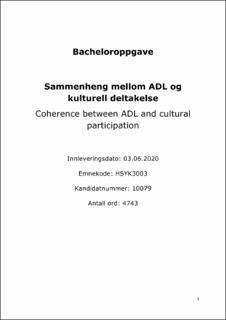| dc.contributor.advisor | Strand, Linn Beate | |
| dc.contributor.author | Øfsti Schjetne, Jørgen | |
| dc.date.accessioned | 2020-07-17T16:03:01Z | |
| dc.date.available | 2020-07-17T16:03:01Z | |
| dc.date.issued | 2020 | |
| dc.identifier.uri | https://hdl.handle.net/11250/2669580 | |
| dc.description.abstract | SAMMENDRAG
Bakgrunn.
I fremtiden vil det bli stadig flere eldre mennesker i Norge. Disse vil møte utfordringer i form av ulike diagnoser og redusert funksjon i sine daglige liv. Det er derfor viktig å se på hva som kan være helsefremmende for de eldre. Kulturell/sosial deltakelse har lenge vært i fokus som et virkemiddel for å bedre eldre menneskers helse og gjøre deres hverdag lettere. Dette er en form for terapi/behandling som staten har satset på, og temaet er belyst av flere forskere rundt i verden. Det vil i denne studien bli satt søkelys på sammenhengen mellom eldres funksjonsevner i dagliglivet (ADL/IADL) og deres kulturelle deltakelse, og hvilken rolle sykepleier har i arbeidet for å øke eldres deltakelse i kulturelle aktiviteter.
Metode.
Dette er en tverrsnittstudie. Denne studien er basert på forskningsprosjektet HUNT4 Trondheim 70+ (2018-19) bestående av 1749 deltakere. Det er hentet data angående sosial/kulturell deltakelse og fysisk funksjon i dagliglivet (ADL/IADL). Dataen kommer fra deltakernes selvutfyllingsskjema. Det er utført statistiske tester for forskjeller i kulturell deltakelse mellom de med god ADL og dårlig ADL.
Resultater.
Etter utført deskriptiv statistikk kom det frem at det var flere kategorisert med god ADL (86%) enn med dårlig ADL (14%). De med god ADL er generelt yngre, har høyere utdanning og bor oftere sammen med noen enn de med dårlig ADL. Kjønnsfordelingen er omtrent lik. Vi fant at de med god ADL har en hyppigere deltakelse i både mottagende- og skapende kulturelle aktiviteter.
Konklusjon.
Denne studien viser at det er en sammenheng mellom ADL og kulturell deltakelse, og at de med god ADL har hyppigere deltakelse enn de med dårlig ADL. I diskusjonen vises det til flere kilder som støtter disse konklusjonene. Det konkluderes videre med at det er viktig at sykepleiere har et salutogent perspektiv i møte med pasienter som har utfordringer med dårlig ADL og lite kulturell delaktighet. | |
| dc.description.abstract | ABSTRACT
Background.
There will be a great amount of elderly people in Norway in the future. Many will face several problems related to medical diagnoses and reduced functionality in their daily life activities. It is therefore important to focus on health-promoting measures. Cultural/social participation has for a long period of time been used as a measure to make the elderlys health increase and make their everyday life easier. This is a form of treatment which is used by the country, and the theme is lightened by several scientists. This study will enlighten the context between elderlys functionality in their daily living (ADL/IADL) and their cultural participation, and what role nurses have in working to increase the elderlys participation in cultural activities.
Methods.
This is a cross-sectional study. The study is based on the science project HUNT4 TRONDHEIM 70+ (2018-19) consisting of 1749 participants. There is collected data regarding cultural/social participation and Activities of Daily Living (ADL/IADL) from the participants self-report questionnaires. There is accomplished statistical analyses for differences in cultural participation between those with god ADL and bad ADL.
Results.
After the execution of the descriptive analyse, it was found that there were more people categorized with good ADL (86%) than bad ADL (14%). Those categorized with good ADL where generally younger, better educated as well as more likely to live with someone. The gender distribution was almost even. We found that those with good ADL has a more frequently participation in both perceptive and active cultural activities.
Conclusion.
This study shows that there is a connection between ADL and cultural participation, and that those with good ADL has a more frequent participation than those with poor ADL. There are several sources that supports this conclusion. There is further conclusion which says that it is important for nurses to have a salutogenetic perspective in meeting with patients who have challenges with poor ADL and small participations in cultural activities. | |
| dc.publisher | NTNU | |
| dc.title | Sammenheng mellom ADL og kulturell deltakelse | |
| dc.type | Bachelor thesis | |
